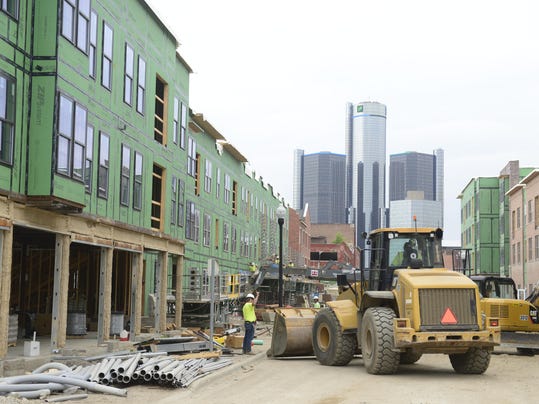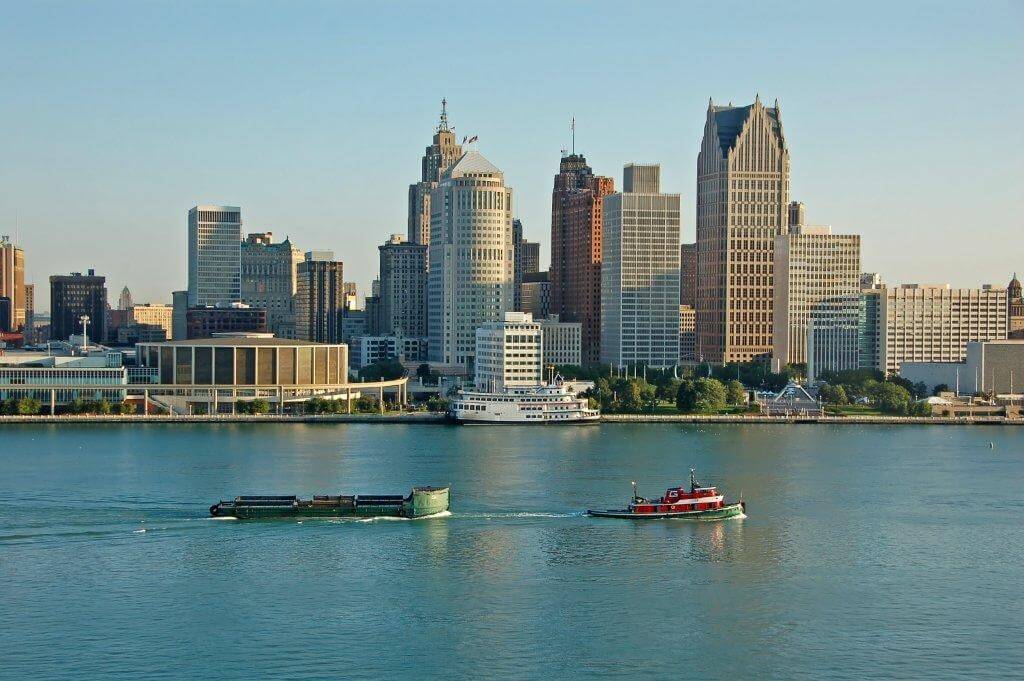Detroit is making steady progress in creating a downtown riverfront that is a popular recreation area, a commercial district and an upscale residential strip.

(Photo: Max Ortiz / The Detroit News)
The riverfront was mainly an industrial and warehouse district for most of the 19th and 20th centuries. Now, more than 3 million people a year use the RiverWalk, the pedestrian/bike path that runs along the river from Belle Isle to Rosa Parks Boulevard. It’s one of downtown’s most popular attractions.
This year, several key projects will bolster the upscale housing scene along the river’s edge. One of those developments is Orleans Landing, the $65 million, 7.7-acre housing and retail complex being built one block from the Detroit River. The facility began accepting leases this month for its 287 apartments. Monthly rent starts at $1,315 for a one-bedroom. The units will be ready for occupancy this fall.
At the groundbreaking for the development last year, Mayor Mike Duggan said, “You get a sense we have fundamentally turned a corner.”
Orleans Landing is at the corner where the RiverWalk links to the Dequindre Cut Greenway, another pedestrian/bike path that leads north to the Eastern Market. The Detroit River is one block away and many apartments, particularly the $2,995-a-month, two-bedroom town homes, will offer commanding views of river and city.
The RiverWalk and the Dequindre Cut were part of the $1 billion that a study by the Detroit Riverfront Conservancy said was invested in the downtown riverfront from 2003 to 2013. Another $1 billion of investment is expected by 2023, the study said.
“The riverfront should be the premier place to live — it’s the most naturally beautiful,” said Matt Lester, founder and CEO of Princeton Enterprises in Bloomfield Township. That’s why Princeton recently bought two key pieces of the massive Stroh River Place, the historical riverfront campus that borders Joseph Campau. It’s one block east of Orleans Landing.
The 25-acre Stroh River Place was once the headquarters of the Parke-Davis pharmaceutical company. Part of the campus dates back to the 19th century. It’s a series of cloistered red-brick buildings. It later became the Stroh Brewery Co.’s headquarters.
Part of the facility now includes condominium units. Another is a office and retail facility that includes the high-end Rattlesnake Club restaurant. Neither the condominiums nor the 300 River Place building with the restaurant was involved in the recent sale.
What Princeton did buy was 500 River Place, which has 301 rental apartments, and Talon Centre at 100 River Place, which is a 67,000-square-foot office building along the river. Princeton bought the apartment building from the Detroit General Retirement System. The Talon Centre building was owned by an entity affiliated to the owner of Lormax-Stern Development Co. in Birmingham. The sales prices were not disclosed and have not yet been publicly recorded.
Beyond the River Place sale, a portion of another upscale riverfront apartment complex, Riverfront Towers, was sold in June to a New York firm. Image Capital LLC and private investors bought two of the three Riverfront Towers for $79.5 million. The New York firm bought the towers that have a total of 577 rental units. The third tower, which has condominiums, was not sold.
The complex next to Joe Louis Arena once counted dignitaries and celebrities such as Rosa Parks, Coleman A. Young and Aretha Franklin as residents. The new owners have promised upgrades to the Riverfront Towers, including restoration of the 77-slip marina that’s been closed for several years.
Image Capital’s other listed holdings include the CNN building in Washington, D.C., and One South Wacker in Chicago.
More big change is coming for 400 acres of riverfront known as the “east riverfront.” The city and the nonprofit that oversees the RiverWalk are working on what will essentially be the road map of how much retail, housing and infrastructure could be built – and how much open space will be preserved.
The area being examined stretches from the eastern edge of the General Motors Renaissance Center to the western border of Gabriel Richard Park, next to Belle Isle. It includes many public and private spaces such as Chene Park Amphitheatre, the UAW-GM Center for Human Resources and the empty Uniroyal site. The latter is one of the former industrial sites the city gained control of and then cleaned up. It’s now looking for a new life.
On Tuesday night, hundreds attended a public meeting that showed drafts of plans in which the riverfront had more parking, buildings, public transportation and open space.
Detroit resident Stacey Price was among the attendees at the Michigan Outdoor Adventure Center, 1801 Atwater, who said they were enthusiastic about the possibilities.
“Every year now the riverfront just gets better and better, I love it,” Price said.



